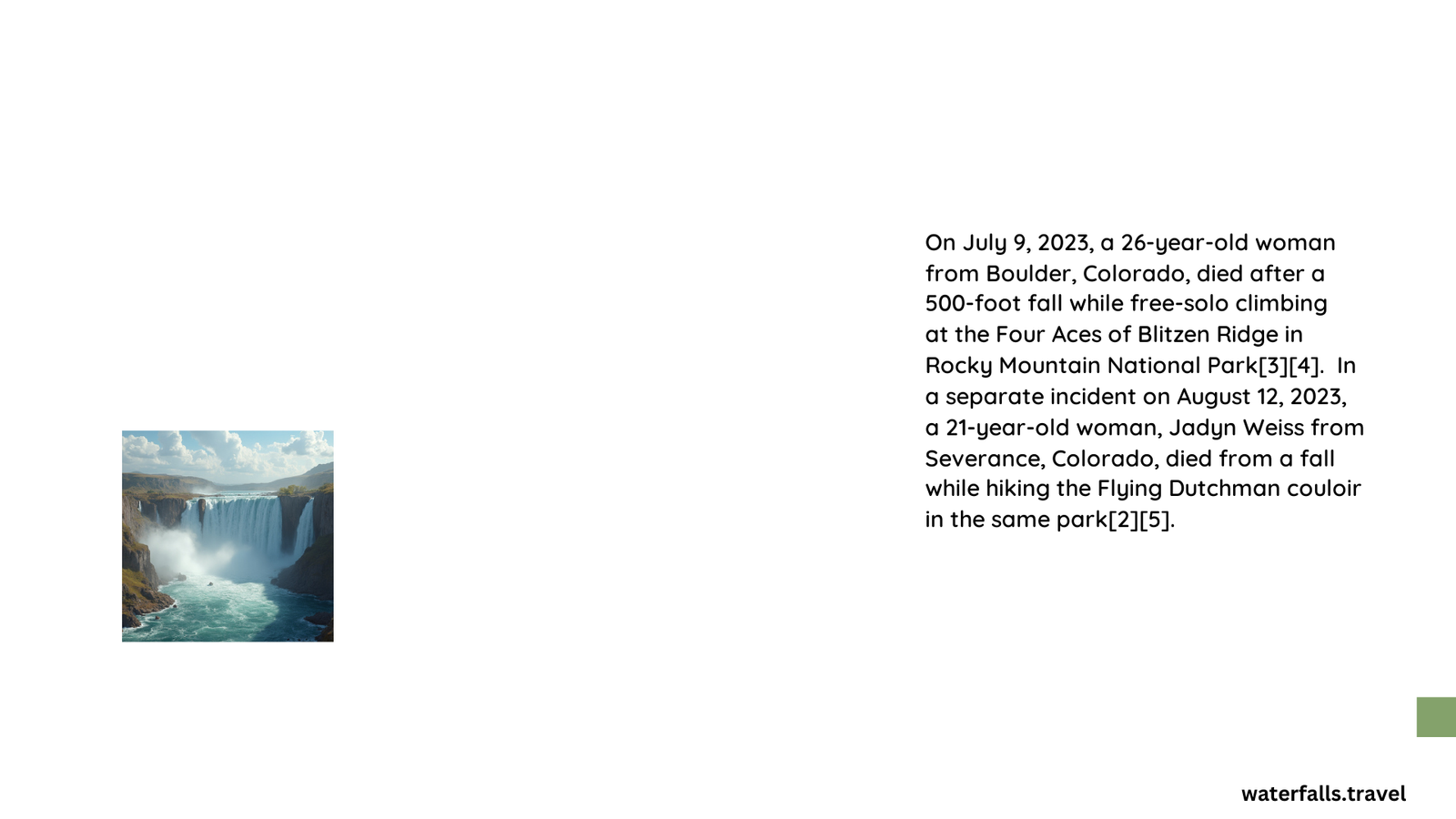Rocky Mountain National Park, renowned for its breathtaking landscapes and diverse ecosystems, has been the site of various incidents involving hikers and waterfalls. While there isn’t a specific waterfall named ‘Woman Falls’, the park’s numerous cascades and streams pose both beauty and potential danger. This article explores the park’s waterfalls, hiking safety, and the mesmerizing experiences awaiting visitors, with a focus on preventing accidents and enjoying the natural wonders responsibly.
What Are the Most Notable Waterfalls in Rocky Mountain National Park?
Rocky Mountain National Park boasts several stunning waterfalls, each with its unique charm:
- Alberta Falls
- Height: 30 feet
- Location: Glacier Gorge Trail
-
Best time to visit: Late spring to early summer
-
Ouzel Falls
- Height: 40 feet
- Location: Wild Basin area
-
Notable for: Powerful cascade surrounded by pine forest
-
Copeland Falls
- Location: Wild Basin area
-
Characteristic: Series of small cascades
-
Chasm Falls
- Height: 25 feet
- Location: Old Fall River Road
- Unique feature: Thunderous waterfall in a narrow gorge
How Can Visitors Safely Enjoy Waterfall Hikes?

Safety is paramount when exploring Rocky Mountain National Park’s waterfalls. Here are essential tips:
- Stay on designated trails
- Wear appropriate footwear with good traction
- Keep a safe distance from water edges
- Be cautious of slippery rocks, especially near waterfalls
- Check weather conditions before hiking
- Carry sufficient water and snacks
- Inform someone of your hiking plans
What Are the Best Trails for Waterfall Viewing?
| Trail Name | Distance (Round Trip) | Difficulty | Notable Features |
|---|---|---|---|
| Alberta Falls Trail | 1.6 miles | Easy to Moderate | Scenic waterfall, mountain views |
| Ouzel Falls Trail | 5.4 miles | Moderate | Multiple waterfalls, diverse landscapes |
| Copeland Falls Trail | 0.3 miles | Easy | Quick access, family-friendly |
| Chasm Falls Trail | 2.5 miles | Moderate | Historic road, dramatic waterfall |
How Does Seasonal Change Affect Waterfall Viewing?
Waterfall experiences in Rocky Mountain National Park vary significantly with the seasons:
- Spring: Peak flow due to snowmelt, powerful and impressive falls
- Summer: Moderate flow, comfortable hiking conditions
- Fall: Reduced flow, beautiful autumn colors surrounding falls
- Winter: Frozen waterfalls, ice climbing opportunities (for experienced climbers only)
What Photography Tips Can Enhance Waterfall Captures?
Capturing the beauty of Rocky Mountain National Park’s waterfalls requires skill and preparation:
- Equipment:
- Wide-angle lens for landscape shots
- Tripod for long exposures
-
Neutral density filters to control light
-
Camera Settings:
- Slow shutter speed (1/15 to 1 second) for silky water effect
- Low ISO (100-400) for crisp images
-
Small aperture (f/11 to f/16) for depth of field
-
Composition Tips:
- Include foreground elements for depth
- Use leading lines to guide the viewer’s eye
- Experiment with different angles and perspectives
How Can Visitors Minimize Environmental Impact While Enjoying Waterfalls?
Responsible tourism is crucial for preserving Rocky Mountain National Park’s natural beauty:
- Practice Leave No Trace principles
- Stay on marked trails to prevent erosion
- Do not disturb wildlife or plant life
- Pack out all trash, including biodegradable items
- Use restroom facilities before hitting the trails
- Respect quiet zones and other visitors’ experiences
What Emergency Procedures Should Hikers Know?
In case of emergencies near waterfalls or on trails:
- Call 911 or park emergency services immediately
- Provide precise location details if possible
- Stay calm and in a safe place while awaiting help
- If trained, administer first aid as necessary
- Signal for help using bright clothing or emergency whistle
How Does Climate Change Impact Rocky Mountain National Park’s Waterfalls?
Climate change is affecting the park’s waterfall ecosystems:
- Altered snowmelt patterns changing peak flow times
- Increased risk of flash floods due to extreme weather events
- Potential long-term reduction in water flow during dry seasons
- Changes in surrounding vegetation affecting waterfall habitats
What Are the Lesser-Known Waterfall Gems in the Park?
While popular falls attract crowds, consider these hidden treasures:
- Timberline Falls
- Location: Sky Pond Trail
-
Unique feature: Multi-tiered falls with alpine views
-
Ribbon Falls
- Location: Black Lake Trail
-
Characteristic: Thin, ribbon-like cascade
-
Fern Falls
- Location: Fern Lake Trail
- Notable for: Secluded setting, lush surroundings
How Can Visitors Contribute to Waterfall and Trail Preservation?
Visitors play a crucial role in preserving Rocky Mountain National Park:
- Volunteer for trail maintenance programs
- Report any trail damage or hazards to park rangers
- Educate others about responsible hiking and viewing practices
- Support conservation organizations focused on the park
- Participate in citizen science projects monitoring water quality and flow
By understanding the beauty and risks associated with Rocky Mountain National Park’s waterfalls, visitors can enjoy safe, memorable experiences while helping to preserve these natural wonders for future generations. Remember, while there isn’t a specific ‘Woman Falls’, every waterfall in the park tells a story of nature’s power and fragility, deserving our respect and protection.
References:
1. U.S. National Park Service – Rocky Mountain National Park
2. Colorado Parks & Wildlife – Hiking Safety
3. Leave No Trace Center for Outdoor Ethics
4. U.S. Geological Survey – Climate Change in Mountain Ecosystems
